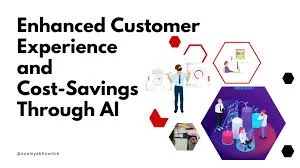Artificial Intelligence (AI) is no longer a futuristic concept — it’s a present-day powerhouse that’s transforming industries across the globe. One of its most impactful contributions is in enhancing customer experience (CX) while simultaneously driving cost savings for businesses. From chatbots and personalization engines to predictive analytics and automation, AI is redefining how companies engage with their customers and optimize their operations.
This article explores how businesses are using AI to deliver better customer experiences, reduce operational costs, and stay competitive in a rapidly evolving digital landscape.
How AI is Improving Customer Experience
Modern consumers expect fast, personalized, and seamless interactions — and AI makes this possible at scale. Let’s break down how AI is elevating the customer journey:
1. 24/7 Customer Support with Chatbots and Virtual Assistants
AI-powered chatbots can handle thousands of inquiries simultaneously, offering instant responses to frequently asked questions. These bots:
Provide round-the-clock support without human intervention
Reduce wait times and increase customer satisfaction
Handle routine tasks, freeing up human agents for complex issues
For example, companies like Amazon, Bank of America (Erica), and Sephora use AI chatbots to streamline customer support and guide users through purchasing or troubleshooting processes.
2. Hyper-Personalization Through Data Analysis
AI algorithms analyze massive amounts of customer data — including browsing behavior, past purchases, and preferences — to deliver tailored experiences. This enables:
Personalized product recommendations (as seen on Netflix, Spotify, and Amazon)
Customized email campaigns and promotions
Dynamic website content based on user profiles
Customers are more likely to engage with brands that offer relevant and timely interactions, which leads to increased loyalty and conversions.
3. Predictive Customer Insights
AI helps businesses predict what customers need before they ask. By analyzing patterns in customer behavior, AI can:
Anticipate churn and trigger retention campaigns
Forecast product demand and inventory needs
Identify upsell and cross-sell opportunities
This proactive approach not only enhances satisfaction but also improves operational efficiency.
4. Voice and Visual Recognition Interfaces
Voice AI (like Siri, Alexa, and Google Assistant) and image recognition technologies are reshaping how customers interact with brands. For instance:
Retailers use visual search tools to help customers find products using images.
Voice commerce allows hands-free shopping and support.
Financial institutions use voice biometrics for secure authentication.
These technologies make the customer experience more intuitive and accessible.
AI-Driven Cost Savings for Businesses.
While AI improves the customer journey, it also reduces overhead costs and increases operational efficiency. Here's how:
1. Automation of Repetitive Tasks
AI can automate a wide range of manual processes such as:
Data entry
Invoice processing
Order fulfillment
Scheduling and resource planning
This reduces the need for large support teams, lowers labor costs, and minimizes human errors.
2. Optimized Customer Service Operations
By handling a significant volume of inquiries through chatbots or AI voice systems, companies can:
Reduce call center staffing needs
Lower training and onboarding expenses
Decrease customer support resolution times
According to IBM, AI chatbots can cut customer service costs by up to 30%.
3. Smarter Resource Allocation
AI tools help businesses forecast demand, monitor supply chains, and allocate resources more effectively. This leads to:
Less waste
Better inventory control
More efficient logistics
For example, AI in retail helps predict peak shopping times and optimize staffing levels accordingly.
4. Fraud Detection and Risk Management
In finance and e-commerce, AI algorithms detect fraudulent activity in real time. These systems:
Minimize revenue loss due to fraud
Reduce the cost of manual audits
Improve compliance with regulatory standards
Faster fraud detection also enhances trust, an essential component of customer satisfaction.
Real-World Examples of AI-Driven Transformation
Starbucks uses AI through its Deep Brew system to personalize customer offers and manage inventory based on location-specific trends.
Delta Air Lines integrates AI to predict maintenance needs for aircraft, ensuring timely service and fewer delays — directly impacting customer satisfaction.
Zara employs AI in logistics to quickly respond to trends and optimize supply chain processes, saving costs and meeting customer demand with agility.
Challenges and Considerations
While the benefits are vast, businesses should consider the following:
Data Privacy: Ethical use of customer data must be a priority.
Integration Costs: Initial investments in AI tools and training can be high.
Bias and Transparency: AI systems must be monitored to avoid biased decision-making or “black box” outcomes.
That said, with proper strategy and implementation, the long-term ROI far outweighs the upfront costs.
Conclusion: The Future of AI in Business
The integration of AI into customer experience and operational models is no longer optional — it’s a competitive necessity. Businesses that leverage AI are not only enhancing the way customers interact with their brand, but also unlocking significant savings and efficiency.
From smarter service to scalable personalization and reduced operational costs, AI is shaping a future where both customers and businesses benefit. As AI continues to evolve, those who embrace its potential today will lead their industries tomorrow.









.jpeg)


0 Comments